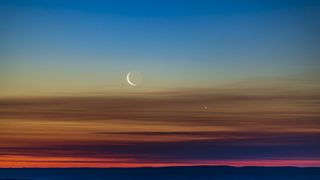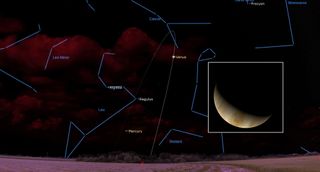
Venus was at inferior conjunction on Aug. 13, in line between the Earth and the sun. Now it is swinging away from that line, speeding ahead of the Earth in its faster orbit.
In fact, Venus has erupted into view in the eastern morning sky during the past couple of weeks. When September opened, this resplendent "Morning Star" was rising just prior to dawn's first glow at around 4:30 a.m. local daylight time. But with each passing morning, Venus has been rising ever higher and has been getting a little brighter; it will attain its greatest brilliance on Sept. 19, appearing at an eye-popping magnitude of -4.8. This is 23 times as bright as the brightest star in the sky, Sirius (in Canis Major, the Big Dog), and seven times as bright as the next-brightest planet, Jupiter.
And by month's end, it's rising just prior to 3:30 a.m. and will precede the sun by some three and a half hours!
Related: Night sky, September 2023: What you can see tonight [maps]

Want to see the crescent of Venus in the morning sky? We recommend the Celestron Astro Fi 102 as the top pick in our best beginner's telescope guide.
Try looking for Venus through the brilliance of the daytime sky. It can be done if you know exactly where to look.
Probably the best method is to simply keep it in view until after the sun comes up. At its current extreme brightness, it can often be perceived as a tiny white speck against the blue backdrop of daylight.
Those who live in rural areas far from any extraneous light have reported that Venus is capable of casting a faint, yet distinct shadow.
Get the Space.com Newsletter
Breaking space news, the latest updates on rocket launches, skywatching events and more!
Greatest illuminated extent
For many years astronomical almanacs and calendars would make reference to the date when Venus arrived at its peak brilliance: "Venus at greatest brilliancy." But beginning in 2009, a new type of nomenclature appeared to describe this occurrence: "Venus at greatest illuminated extent."
When Venus appears as a full or a nearly fully illuminated disk, it appears rather small in angular size through telescopes. That's because Venus is on the other side of the sun as viewed from Earth — some 160 million miles (257 million km) away. Conversely, when Venus is passing closest to Earth — 26 million miles (42 million km) — its disk swells tremendously; roughly to 1/30 of the apparent size of the full moon. But because most of the dark side of Venus is directed toward Earth, all we can see of it at best, is an exceedingly thin crescent, perhaps no more than a few percent illuminated by the sun.
Somewhere in between these two extremes, is a compromise, where Venus appears relatively large, while displaying a significant fraction of the illuminated portion of its disk. That comes when the disk of Venus appears one-quarter illuminated — much more than when it's nothing more than a hairline crescent — and at the same time, it's roughly 41 million miles (66 million km) from us and its apparent disk size is about two-thirds that of when it appears largest.

Thus, the greatest illuminated extent of Venus' disk coincides with its greatest brilliancy.
And interestingly, its pinnacle of brilliance this month is not limited to just one day, but runs from Sept. 16 through Sept. 26. So, through a telescope during September, it displays a large, brilliant, beautiful crescent that waxes in phase all month while shrinking in size.
When September opened, Venus was only 12-percent illuminated, but by month's end, that figure will have increased to 36-percent; but because it will have receded 17 million miles (27 million km) from Earth, it will appear more than one-third smaller than it did at the start of the month.

Planetary, stellar and lunar meetings
On the same morning that Venus is at greatest brilliancy (Sept. 19), wait until about an hour before sunrise and then, using your clenched fist at arm's length (which measures 10 degrees in width), go roughly "two fists" to Venus' lower left to catch sight of much fainter Mercury, the smallest planet of the solar system.
Also, during the coming weeks, Venus will also be floating ever closer to the bright 1st-magnitude star Regulus in Leo the Lion. By the end of this month, Venus and this bluish star will be separated by about 8 degrees.
And come Oct. 10, as Venus is passing about 2.5 degrees below Regulus, a lovely crescent moon will be passing just to the north of both star and planet and will make for an eye-catching configuration in our predawn sky.
If you are hoping to catch a look at Venus, our guide to best binoculars are a great place to find some wide-angle optics that can give you a nice view of the planet on-the-go. But if you want to get a more up-close look at the thin crescent of Venus in the night sky, check out our guides to the best telescopes or the best budget telescopes.
And you're looking to snap photos of Venus or the night sky in general, check out our guide on how to photograph the planets, as well as our best cameras for astrophotography and best lenses for astrophotography.
An oldie, but a goody
Thoughts of viewing the crescent of Venus always reminds me of an amusing story related by George Lovi (1939-1993) a well-known astronomy lecturer and author who was also a good friend of mine. I've related this story on Space.com before, but it's worth retelling again.
One night, while George was running a public night at the Brooklyn College Observatory in New York, the telescope was pointed right at Venus which — as now — was then displaying its delicate crescent shape. Yet one student gazing through the telescope eyepiece stubbornly insisted he was not looking at Venus, but at the moon instead. When George commented that the moon wasn't even in the sky, the student replied, "So what? Doesn't a telescope show you things you can't see without it?"
Joe Rao serves as an instructor and guest lecturer at New York's Hayden Planetarium. He writes about astronomy for Natural History magazine, the Farmers' Almanac and other publications.
Editor's Note: If you snap an image of Venus and would like to share it with Space.com's readers, send your photo(s), comments, and your name and location to spacephotos@space.com.
Join our Space Forums to keep talking space on the latest missions, night sky and more! And if you have a news tip, correction or comment, let us know at: community@space.com.

Joe Rao is Space.com's skywatching columnist, as well as a veteran meteorologist and eclipse chaser who also serves as an instructor and guest lecturer at New York's Hayden Planetarium. He writes about astronomy for Natural History magazine, the Farmers' Almanac and other publications. Joe is an 8-time Emmy-nominated meteorologist who served the Putnam Valley region of New York for over 21 years. You can find him on Twitter and YouTube tracking lunar and solar eclipses, meteor showers and more. To find out Joe's latest project, visit him on Twitter.
